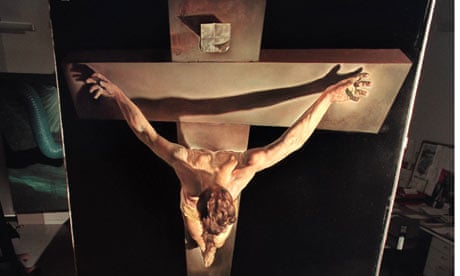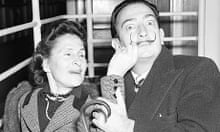For more than half a century, Salvador Dalí's dark and dramatic rendering of Christ's crucifixion has been regarded as his finest religious painting, attracting millions of visitors to an apparently modest municipal art gallery in Glasgow.
But now, 57 years after being bought direct from the artist by Glasgow's city fathers, the painting is at the centre of a legal investigation which may yet snare a death metal band from Alsace in France, ashtray manufacturers, and poster-makers in the US, Britain, Italy and Spain.
The council believes it has been losing tens of thousands of pounds in unpaid licensing fees and royalties a year from unauthorised copies of Christ of St John of the Cross, which was bought for £8,200 and now valued at more than £60m.
Lawyers acting for Glasgow city council have drawn up a hit-list of 50 companies, manufacturers and artists selling hand-painted copies, who are suspected of illegally copying it. Warnings have been issued to 25 firms and individuals across the world - some wrongly claiming to have the council's permission to reuse the image - to "cease and desist" or face legal action.
After intellectual property experts at Burness, the Glasgow-based law firm hired by the council, have finished with the largest suppliers of unapproved copies, the French rock band Mercyless may be next in line. The band's 1992 album Abject Offering, which features such tracks as Unformed Tumours and Burned at the Stake, has a cropped version of the painting on its cover. A council spokesman said the band was refused permission to use the painting but claimed on the album cover it was authorised to do so.
Archie Graham, the council's executive member for culture and sport, said this was another good reason for keeping a close eye on its reproduction: its religious subject matter and significance had to respected. "It's an issue of the image being reproduced in an appropriate manner. We don't want to see tacky goods having the image on them."
In a highly unusual move, Dalí gave Glasgow sole copyright to the painting when he sold it in 1951. Apparently in financial difficulties, Dalí initially asked for £12,000 but after some hard bargaining by Tom Honeyman, the director of Glasgow Art Gallery at the time, he sold it for nearly a third less and signed a letter to the city in 1952 ceding copyright.
Coming only seven years after the end of the second world war, the purchase proved extremely controversial. The protests against its acquisition - on the grounds that the money would be better spent on the college and the city's own residents - even attracted the support of students at Glasgow's School Of Art.
In fact, the painting cost the city's rate-payers nothing: it was bought by a fund set up using the profits of the Kelvingrove International Exhibition of 1901 to buy works of art for the city's museums.
It has been in the news ever since. In 1961, the stark image was attacked by a man with mental health problems who slashed it with a stone and a knife. In the early 80s, someone shot at its protective Perspex cover with an airgun.
Yet Honeyman is now regarded as a visionary and a hero, said Graham. The council estimates that its licensing has earned the authority at least £50,000 in royalties as well as shifting the gallery's own Dalí postcards and placemats - repaying its original cost many times over.
Christ of St John of the Cross is also Kelvingrove's greatest asset, helping make the gallery and museum Scotland's most popular visitor attraction and putting it 14th in a world ranking of major galleries, ahead of the Uffizi in Florence, Tate Britain in London, and the Museum of Modern Art in New York. Since it reopened after a £35m refurbishment in 2006, Kelvingrove has had 5 million visitors.
The council now earns about £2,000 each year from approved reproductions but its legal advisers estimate that unauthorised copies are losing the city well over five times that sum, thanks largely to the proliferation of mail order businesses selling posters online.
"At the time, they argued the money could have been better spent," said Graham. "It was a different era then, but the city fathers stuck to their guns, and we're glad that they did."
Colin Hulme, the intellectual property lawyer handling the case for the council, said their initial investigations had found that a handful of printing firms were responsible for a large proportion of the illicit copies. They may be asked or forced to repay royalties going back some years, he said.
Some firms even claimed to have authority to reprint Christ of St John of the Cross from the Gala-Salvador Dalí Foundation in Figueres, Spain, which oversees copyright for most Dalí works. But that claim was firmly denied yesterday by a spokeswoman for the foundation. "It's a very rare case that Dalí sold the work and the rights," she said. "But I can confirm that the owner of the painting does also own the copyright."


